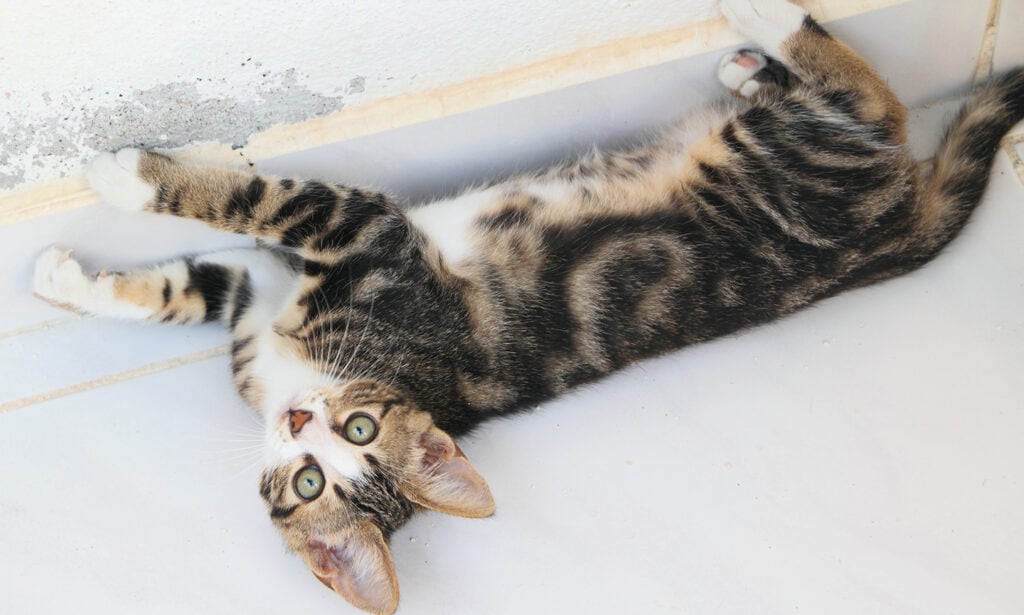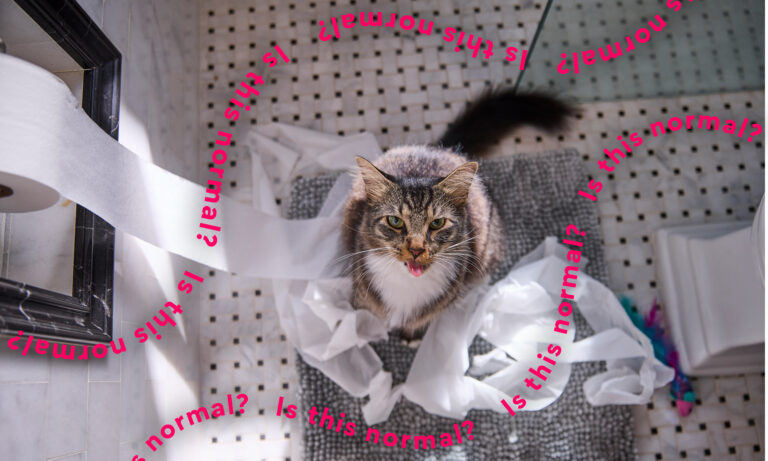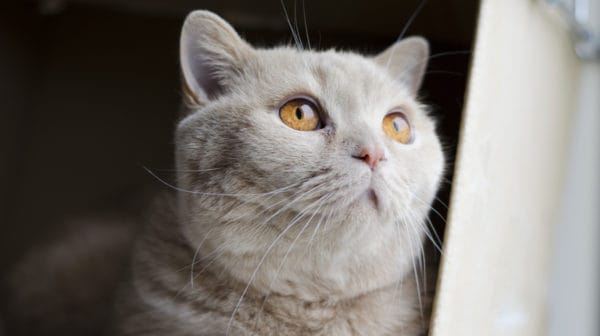Scratching is a common and natural behavior that’s observed in wild felines, and it’s no different our domestic kitties, some of which love to utilize the long and textured surface of a wall to satisfy their clawing desires. But, if your cat scratches walls on a regular basis, this normal behavior becomes frustrating and oftentimes destructive.
Two behavioral veterinarians assure us there’s a solution to getting your cat’s claws off the walls and onto a more appropriate scratching surface. The first step is figuring out why cats scratch. Then you can implement a behavior management strategy that works for both your cat and your walls.
Why Do Cats Scratch Walls?
“Cat scratching is nearly always behavioral,” says Dr. Bruce Kornreich, DVM, director of Cornell University’s Feline Health Center in Ithaca, New York. This means that scratching is rarely a medical problem unless there are other signs of disease, such as changes in appetite, activity levels or urination habits, or discharge from eyes or nose. Cats don’t scratch to intentionally destroy or be spiteful, but rather to ensure their safety by sending messages to other cats and keeping themselves physically healthy.
The top 4 reasons why cats scratch walls:
1. Mark Their Territory
Scratching releases pheromones, or a strong scent unique to each cat, that effectively mark a cat’s territory. Pheromones are detected only by cats and are released from small areas on your cat’s paws, among other places, called interdigital glands.
Depositing pheromones helps cats of any breed or age feel safe in their homes, by claiming stake to walls or furniture, regardless if it’s a single or multi-cat household. This reassuring scent entices the cat to return to the same scratching spot because the spot is claimed as theirs.
“Cats do this to avoid conflict with other cats,” says Dr. Kornreich. “It’s a self-preserving mechanism.”
Cats may also be leaving messages that areas are safe, establishing a hierarchy, warning other cats to stay clear or making a statement about food or litter.
However, marking territory doesn’t apply to humans; cats typically don’t scratch for our attention, says Dr. Kornreich.
2. Keep Their Claws Sharp and Healthy
Scratching down on a textured surface, like your wallpaper, sheds the outer layer of the nail, called the sheath, leaving behind a sharp and healthy claw. Unlike human nails, which grow straight, cat nails grow in layers. As the nail gets worn out from climbing or hunting, the outer layers lose blood supply, becoming dull and ready for removal.
Sharpening nails is a self-preserving mechanism that ensures cats can climb trees to escape from predators, explains Dr. Erica Hawker, DVM, veterinarian at Union Lake Veterinary Hospital in Waterford, Michigan, who specializes in animal behavior.
“Cats also use sharp nails to catch prey outside, which is an instinctual behavior even if they are fed by their owners regularly,” she says.
3. Stretch Back Muscles and Spine
Reaching high up on a wall to get a full body stretch doesn’t just feel good to cats, it aids in their quick movements and graceful twisting, high jumps and soft landings.
“Stretching keeps cats flexible,” says Dr. Hawker of their ability to both extend and flex their back muscles to reach full speed and conversely, contract their bodies to fit into tight spaces.
4. Express Stress or Anxiety
Excessive scratching that happens all over the house on a variety of surfaces (floors, walls, furniture, carpet) may be a sign that your cat is stressed.
“Cat anxiety is often overlooked,” says Dr. Hawker. Your vet can help you figure out whether your cat’s scratching pattern is stress-related or a behavior that can be managed with scratching alternatives.
“Noting where they are scratching is really important,” says Dr. Kornreich. If the scratching is widespread, it’s likely a sign of stress. If it’s persistent and solely in one place, the cat may be protecting a resource, such as food, water or litter box, he explains. As a general rule, provide one extra litter box than there are cats in the house.
Why Is My Cat Scratching the Walls at Night?
Cats are crepuscular, meaning they are most active at dawn and dusk. So, it’s in their DNA to become more playful during the darker hours.
“Sometimes, we forget to play with our cats,” Dr. Hawker says, which can lead to boredom and unwanted behaviors, such as furniture and wall scratching, during their naturally most active times of the day.
If the early morning, or in some cases, night scratching—although, this is less common—is keeping you up, enhance your cat’s exercise routine during the day and right before your bedtime, says Dr. Hawker.
Provide interactive engagement toys to occupy your cat at night and increase playtime during the day. People naturally think you need to wear out your dog with fetch and walking, says Dr. Hawker, but physical and mental stimulation are equally important for cats.
How to Stop Cats Scratching the Walls
Rather than interrupt or punish your cat for their instinctual scratching behavior, redirect it to a more appropriate scratching surface, such as a cat scratching post or wall pad. “We don’t recommend punishment because it increases anxiety, and that fuels a lot of other problem behaviors,” says Dr. Hawker.
These tips from our experts help your cat to stop scratching walls:
Remove the Scent
Because the pheromones encourage a cat to return to a scratching spot, wash the area thoroughly with soap and water. Then, use Feliway spray, a synthetic pheromone that mimics natural calming pheromones, sending your cat the message that this area no longer needs a scratch. To deter your cat from entering an entire room, a Feliway diffuser releases a more widespread synthetic scent.
Strategically Place Scratching Alternatives
Scratching posts, multi-level cat trees or wall-mounted scratch pads near the spaces where your cat scratches. Designate multiple scratching areas, especially in a multi-cat house, so there’s plenty of turf to go around.
Offer a Variety of Scratching Surface Textures
Scratching posts, trees and pads come in a variety of textures, including cardboard, wood, carpet and sisal rope. Pick the one(s) based on what your cat scratches in your house. This will be a trial-and-error process to see what your cat naturally prefers.
Use Positive Reinforcement Around the Approved Scratching Surface
Encourage your cat to use the new scratch post with interactive playtime near the area, offering treats and sprinkling catnip on the spot your cat should scratch. Follow with abundant praise to reinforce the good behavior. Once your cat starts regularly using the new scratch surface, incrementally move it to a desirable area of your house.
Trim Your Indoor Cat’s Nails Regularly
Do this every few weeks. Regular maintenance helps the outer, dead sheaths shed quickly, which will decrease her need to sharpen by scratching. Cut the tip of the nail carefully with cat clippers to avoid hitting the nerve-filled quick, which is located mid-nail and is painful and will bleed if cut. Declawing is not recommended by veterinarians.
Cat Scratch Pads for Walls
An alternative to the common scratching post, wall scratch pads are either mounted on or leaned against the wall in the spot where your cat scratches. The pads come in various surface materials and can be secured with screws either flush to the wall, at an angle or wrapped around a corner.
“The owner’s job is to provide the pads as close as they can in terms of orientation, location and surface and when they use that new surface, praise them like crazy,” says Dr. Kornreich.
Place the scratch pad at a similar height to where your cat is naturally stretching and scratching. Then entice her by sprinkling catnip in the pad or purchasing one with catnip included. Always reward good behavior with treats and praise.
Looking for a scratch pad your cat can sink their nails into? Check out these cat scratcher products:
Why Is My Cat Scratching the Floor?
Cats scratch the floor for similar reasons they scratch the walls. It’s just that some cats prefer the feel of carpet or rough area rugs over hard surfaces. This texture preference is key when choosing the material for your scratching post or pad.
Although it may seem like an easy conclusion, scratching the floor near a litter box or food bowl doesn’t necessarily mean your cat is unhappy with those things, says Dr. Kornreich. If a cat is dissatisfied, there will be other behaviors associated with the scratching, like refusal to eat altogether or misusing the litter box.
For example, cats naturally cover their poop with litter. If they’re scratching in addition to urinating outside the box, or jumps out immediately after use, change the type of litter to a texture they prefer, says Dr. Hawker.
Brush up on cat behavior:
Share:


















